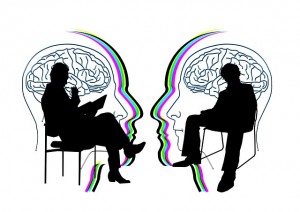Approximately 90 per cent of communication is exchanged non-verbally and most of that is done in an unconscious way. We use 30 of our 90 facial muscles to convey non-verbal communication (www.counsellingconnection.com) The body’s innate intelligence is an untapped resource in psychotherapy (www.sensorimotorpsychotherapy.org).
 You have learnt about non-verbal communication in your counselling graduate studies. It is an essential skill to be able to pick up on subtle non-verbal cues your clients exhibit in session. Most times, a client may not be able to put into words or articulate how they really feel. Non-verbals can speak for them. These non-verbals demonstrate a client’s status in their eye contact, facial expressions, their body movements and in their posture. For example, a depressed client may exhibit a slumped body posture, with their head mostly down, shoulders down, eye contact limited and they may seem to reflect a body posture that turns inward and makes them appear smaller. Most times a client’s non-verbals will match what they are conveying to you verbally about their situation and sometimes there will be an incongruency between what is verbalised versus expressed in body language. It’s an important skill to notice non verbal communication and another skill to be able to incorporate that into therapy by reflecting back what you have observed. Often times client’s are not even aware of the messages their bodies are conveying. Helping them become aware can facilitate body awareness in times of relationship conflicts where others may perceive their body language as threatening or in any other negative fashion.
You have learnt about non-verbal communication in your counselling graduate studies. It is an essential skill to be able to pick up on subtle non-verbal cues your clients exhibit in session. Most times, a client may not be able to put into words or articulate how they really feel. Non-verbals can speak for them. These non-verbals demonstrate a client’s status in their eye contact, facial expressions, their body movements and in their posture. For example, a depressed client may exhibit a slumped body posture, with their head mostly down, shoulders down, eye contact limited and they may seem to reflect a body posture that turns inward and makes them appear smaller. Most times a client’s non-verbals will match what they are conveying to you verbally about their situation and sometimes there will be an incongruency between what is verbalised versus expressed in body language. It’s an important skill to notice non verbal communication and another skill to be able to incorporate that into therapy by reflecting back what you have observed. Often times client’s are not even aware of the messages their bodies are conveying. Helping them become aware can facilitate body awareness in times of relationship conflicts where others may perceive their body language as threatening or in any other negative fashion.
There are many theories and therapies that utilise nonverbals. Sensorimotor psychotherapy, developed by Pat Ogden in the 1970’s, correlates the disconnection trauma victims feel in their bodies with their physical patterns and their psychological issues. Sensorimotor psychotherapy joins somatic therapy with psychotherapy (www.sensorimotorpsychotherapy.org). Somatic therapy is another holistic therapy that studies the relationship between the mind and the body in regard to psychological past. The word “soma” is a Greek word that means living body. Somatic therapy shows how trauma symptoms and their effects on the autonomic nervous system and how these effects can fester into prominent physical symptoms, digestive issues, hormonal imbalances, sexual dysfunctions, depression, anxiety and addictions (http://psychcentral.com/). In addition, other therapies utilise non verbal communication to some degree. Emotion focused therapy relies on body language to convey emotions and work directly with them. Biofeedback is another therapy that tracks specifically body language by use of monitors or biofeedback machines to ease anxiety and stress. There are many more, of course. Can you think of one that has intrigued you or one therapy that you use specifically in your therapy sessions that utilises the body/body language?
Cultural practices as well as the context and environment should all be considered when observing non verbal communication. Body language in these respects can be misinterpreted depending on the context. We can easily clarify with our clients to see if our perception matches what is observed.
Counsellors should also get into the practice of regulating their own non verbal communication as their own non-verbals can hinder or foster the therapeutic alliance with clients. Next time you are in session, reflect on your body posture and what your body language is saying to your clients. If you are in the practice of taping your sessions (with client permission) can you observe directly these messages?
The topic of non-verbal communication can evoke many sub-topics and can be written about for days. The essence of this blog is to tap into it’s importance for psychotherapy and to guide psychotherapists in developing their skills further. The body is a fascinating tool in psychotherapy that can give us more information about psychological issues.
References:
http://www.counsellingconnection.com/wp-content/uploads/2009/10/report-1-verbal-and-non-verbal-communication-skills.pdf
http://psychcentral.com/blog/archives/2014/09/12/how-somatic-therapy-can-help-patients-suffering-from-psychological-trauma/
https://www.sensorimotorpsychotherapy.org/index.html
*The views expressed by our authors are personal opinions and do not necessarily reflect the views of the CCPA